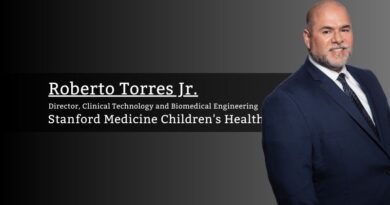Three Technology Considerations to Maximize Efficiency in the Operating Room (OR)
By Dr. Alexis Burnett, VP of Surgical & Procedural Services, Medical City Healthcare
The post-pandemic staffing crisis, combined with high healthcare costs, has intensified the focus on waste reduction. Waste significantly impacts patients, hospitals, and health systems. Leveraging technology is one way for surgery leaders and hospital administrators to reduce waste in the operating room (OR). There are three types of technologies that should be considered for maximizing efficiency in all hospitals and ambulatory surgery centers (ASCs).
Technology increases automated documentation
Any technology that decreases the amount of manual documentation required by the OR team will improve efficiency. One of the best systems is a radio-frequency identification (RFID) system. RFID is a technology that leverages tags to relay information to electronic readers. A tag is placed on a patient’s chart, which accompanies them throughout the operative journey. Tag readers are placed throughout the OR. As the patient/chart passes the tag readers, the patient’s journey becomes automatically timestamped. The time when a patient enters the OR and when a patient exits the OR are automatically captured and documented in the medical record. The timestamps are often manually entered into the medical record by the OR team, so the RFID system decreases the documentation and improves efficiency.
Years ago, RFID systems were not very accurate. However, advancements in this technology make it one of the top 3 types of technologies that hospitals should evaluate and consider in 2024.
Technology in the OR should be progressive. It should consider ways to maximize resources while maintaining excellent patient outcomes.
Technology enhances communication
Both team communication and patient/family communication are critical for high efficiency. Delays, or perceived delays, in the OR are often avoidable and dependent upon clear communication. Advancing technology in an OR to provide increased communication to patients, surgeons, and anesthesiologists will support efficiency and maximize satisfaction. Most hospitals and ASCs have patient trackers in the waiting room lobby. These HIPAA-compliant trackers are convenient and provide updates to family members on the patient journey. This is an example of a baseline technology platform. There have been enhancements to several of these platforms. One of these enhancements is a text message alert when case changes occur. For example, a recent technology being evaluated for Medical City Healthcare, a 20-hospital system in North Texas, sends a text message to the physician and anesthesiologist if the case will start sooner than scheduled or when there will be a delay. The text also notifies the team of any room changes. These push notifications via text message provide synergy and coordination, reducing waste. These push text notifications allow the team to plan their time proactively. It decreases unnecessary room set-up and tear down which wastes supplies. The notification also allows surgeons and anesthesiologists to prioritize their time versus sitting and waiting for a case or being late to a case that was bumped up.
Medical City Healthcare also has a patient/family texting feature integrated into our electronic infrastructure. This feature is available to opt-in during the registration process. Patients and families who decide to opt-in receive text message notifications throughout the surgical journey.
Technology leverages predictive modeling
Running an OR is similar to playing a game of Tetris. There are a lot of moving pieces that have to fit together perfectly. In order to make every piece fit together perfectly, predictive modeling technology is essential. Case length, or case duration, is one of the most challenging components of running a seamless OR. Often, there are varying opinions regarding how long a case is really going to take. When a case duration is inaccurate, it can throw the remainder of the day into delays and create significant operational challenges.
There are technologies that generate case duration based on several inputs versus traditional models of case duration. Traditionally, an OR will schedule case duration based on a surgeon’s case duration average, what the surgeon’s office recommends, or how long the surgeon thinks it will take to complete the case. Case duration can drastically change based on team composition. For example, adding a first assist or a resident to a case can significantly alter the expected case duration. Advancements in predictive modeling allow the OR schedulers and teams to optimize time by improving schedule duration accuracy.
Technology in the OR should be progressive. It should consider ways to maximize resources while maintaining excellent patient outcomes. Increasing automated documentation, enhancing communication, and leveraging predictive technology are the three considerations moving into 2024. Before incorporating new technology or adopting enhancements, questions that I always ask:
- Will it benefit our patients and the community we serve?
- Will it benefit our teams?
- Does it integrate/interface with the technology that we already have?
If the answer is yes, it is worth your time.



